intercricket manual - Ecb - England and Wales Cricket Board
intercricket manual - Ecb - England and Wales Cricket Board
intercricket manual - Ecb - England and Wales Cricket Board
Create successful ePaper yourself
Turn your PDF publications into a flip-book with our unique Google optimized e-Paper software.
Introduction<br />
Introduction to Inter <strong>Cricket</strong><br />
Inter <strong>Cricket</strong> is a new format of the game, created by the <strong>Engl<strong>and</strong></strong> <strong>and</strong> <strong>Wales</strong> <strong>Cricket</strong> <strong>Board</strong>,<br />
to bridge the gap between Kwik <strong>Cricket</strong> <strong>and</strong> hardball cricket.<br />
Inter <strong>Cricket</strong> enables both boys <strong>and</strong> girls to learn about <strong>and</strong> experience the game of<br />
cricket, whether in the school, club or neighbourhood environment. The new rules <strong>and</strong><br />
specially designed equipment mean that the game can be played safely indoors <strong>and</strong><br />
outdoors, on almost any surface.<br />
Previous experience of Kwik <strong>Cricket</strong> may benefit some pupils but is certainly not essential.
Introduction<br />
NatWest <strong>and</strong> ECB’s Involvement in Inter <strong>Cricket</strong> <strong>and</strong> Schools<br />
NatWest has supported cricket for 25 years <strong>and</strong> Inter <strong>Cricket</strong> is its first schools-based<br />
activity. This initiative seeks to significantly raise the profile of cricket in schools by<br />
introducing cricket to a new generation.<br />
ECB <strong>and</strong> NatWest are wholly committed to supporting Inter <strong>Cricket</strong> in schools <strong>and</strong> through<br />
Get Inter <strong>Cricket</strong> to enable teachers to teach Inter <strong>Cricket</strong> with confidence <strong>and</strong><br />
creativity. ECB has designed these resources as a tool for teachers to assist them in<br />
implementing effective <strong>and</strong> memorable Inter <strong>Cricket</strong> lessons. They also aim to encourage<br />
schools to foster student ability <strong>and</strong> interest so that students will want to further their<br />
participation by accessing the activities of the local cricket club. A complementary DVD<br />
<strong>and</strong> on-line resources have been designed to accompany this folder, <strong>and</strong> to provide<br />
additional ideas, whilst you may also wish to explore the ECB website for further<br />
information <strong>and</strong> support – www.ecb.co.uk/<strong>intercricket</strong>.<br />
Above all, ECB seeks to elevate the profile of cricket in schools, by providing this support<br />
for teachers <strong>and</strong> students with a range of materials relevant to all age groups <strong>and</strong> ability<br />
levels. The core skills of fielding, running, striking <strong>and</strong> throwing underpin the basic<br />
requirements of many other sports; mastery of these provides a strong platform for<br />
students’ progression elsewhere, <strong>and</strong> develops a student’s confidence, balance <strong>and</strong> coordination.
Introduction<br />
Introduction to the Resources<br />
What is Get Inter <strong>Cricket</strong>?<br />
Get Inter <strong>Cricket</strong> is a multi-media cricket curriculum resource that has been designed<br />
for use in secondary schools to assist teachers in the planning <strong>and</strong> delivery of cricket for<br />
the 11-14 age group. The resources have been developed in conjunction with experienced<br />
cricket experts <strong>and</strong> organisations <strong>and</strong> with practising teaching professionals in <strong>Engl<strong>and</strong></strong><br />
<strong>and</strong> <strong>Wales</strong>. The entire Get Inter <strong>Cricket</strong> educational offering, which also includes<br />
resources for cricket clubs, introduces an exciting way for pupils of all ages <strong>and</strong> abilities to<br />
develop their skills <strong>and</strong> progress toward the st<strong>and</strong>ard game.<br />
What does Get Inter <strong>Cricket</strong> offer?<br />
This pack has been specifically designed to develop basic cricket skills for all students<br />
aged 11-14, including striking, fielding <strong>and</strong> bowling. The resource encourages the<br />
development of these skills as well as playing in a team <strong>and</strong> with pupils of different ages<br />
<strong>and</strong> abilities.<br />
The structure of the resource is designed to support teachers in exploring a variety of<br />
teaching styles, moving away from the traditional teacher-centred style of lesson delivery<br />
<strong>and</strong> encouraging inclusive student-focussed lessons with maximum student participation.<br />
Amongst students of this age teachers should encourage independent <strong>and</strong> self-guided<br />
learning, <strong>and</strong> the format of the task cards has been designed with this in mind. The<br />
breadth of activities provide teachers with an opportunity to adapt lessons to incorporate<br />
different styles, often enabling the use of multiple teaching styles in one lesson to meet<br />
your learning outcomes.<br />
Get Inter <strong>Cricket</strong> has been created to motivate students in every activity by<br />
encouraging the participation of everyone, regardless of ability, <strong>and</strong> shifting the focus to<br />
the improvement of a student’s personal performance rather than winning or losing. This<br />
encourages all students to try their best <strong>and</strong> to set personal goals to improve their own<br />
performances.<br />
For maximum flexibility each activity contains several variations to allow its ongoing use<br />
with students of different ages <strong>and</strong> progressive ability. Combine one activity with another<br />
to provide further variations <strong>and</strong> ideas for delivery <strong>and</strong> to ensure that all students’ needs<br />
are met; there are no rules as to how these cards are used - you will find an approach that<br />
best suits your teaching style <strong>and</strong> opportunities. This is not a scheme of work but a<br />
resource to enhance learning experiences.
Introduction<br />
How to use this Resource<br />
The Get Inter <strong>Cricket</strong> resource comprises a ring-bound folder divided into sections,<br />
containing:<br />
• 1 x 36 page ‘loose-leaf’ <strong>manual</strong><br />
• 12 x A4 task cards (which can be photocopied)<br />
• 4 x A4 wet weather activity work sheets (which can be photocopied)<br />
• 6 x A3 posters for the classroom or sports centre – each of these demonstrates a<br />
core skill<br />
Task Cards<br />
Manual Layout <strong>and</strong> Contents<br />
The <strong>manual</strong> is divided into six sections:<br />
1. Inter <strong>Cricket</strong> <strong>and</strong> PE 4. Fitness <strong>and</strong> Activities<br />
2. Playing Inter <strong>Cricket</strong> 5. Useful Extensions<br />
3. Task Cards 6. Additional Resources
Introduction<br />
Inter <strong>Cricket</strong> <strong>and</strong> PE<br />
Contains sections on:<br />
• how this resource supports your teaching of the curriculum<br />
• the transition between late primary (<strong>and</strong> Kwik <strong>Cricket</strong>) <strong>and</strong> early secondary<br />
school<br />
• maintaining pupils’ interest in cricket<br />
• how to maximise inclusion, working with students with all levels of ability <strong>and</strong><br />
need. And introducing various roles to ensure full participation by all students at<br />
all times<br />
Playing Inter <strong>Cricket</strong><br />
Contains information on:<br />
• Inter <strong>Cricket</strong> equipment<br />
• how Inter <strong>Cricket</strong> can be adapted for play indoors or outdoors<br />
• health <strong>and</strong> safety information<br />
Task Cards<br />
This section contains twelve task cards that have been specifically designed to encourage<br />
students in learning through physical activity.<br />
Fitness <strong>and</strong> Activities<br />
Contains sections on:<br />
• fitness<br />
• competition models for application within a school environment<br />
• wet weather activities
Introduction<br />
Skill Posters<br />
The resource materials also include six A3 posters featuring images <strong>and</strong> key aspects of<br />
Inter <strong>Cricket</strong> technique. For display in the sports centre or classroom, they are intended to<br />
complement your teaching <strong>and</strong> inspire pupils to maximise their potential.<br />
Finally, we wish you every success in the use of these resources in your Inter <strong>Cricket</strong><br />
teaching, <strong>and</strong> in your integration of the sport’s principles within other areas of the<br />
curriculum.<br />
Invite your school to develop their Inter <strong>Cricket</strong> delivery <strong>and</strong> capabilities, identifying<br />
additional resources you might access. Inspire your students with real motivation <strong>and</strong><br />
potential, <strong>and</strong> who knows, you may find yourself responsible for instilling a life-long love<br />
of sport <strong>and</strong> cricket, or the identification of future cricket heroes!
Inter <strong>Cricket</strong> <strong>and</strong> PE<br />
Inter <strong>Cricket</strong> <strong>and</strong> the Curriculum<br />
Get Inter <strong>Cricket</strong> supports the delivery of the Physical Education Curriculum through the<br />
running, striking, fielding <strong>and</strong> throwing activities provided within this resource. However,<br />
these activities have been designed so that the skills they develop also transfer <strong>and</strong><br />
underpin the broader physical education curriculum. Developing skills in striking for<br />
instance will assist transfer of skills in softball, whilst throwing skills (accuracy) immediately<br />
support the delivery of other team sports such as netball, tennis <strong>and</strong> rugby.<br />
Inter <strong>Cricket</strong> <strong>and</strong> Cross Subject Learning<br />
Inter <strong>Cricket</strong> has clear links to other KS3 curricula, not just PE. Task cards feature a<br />
curriculum link with relevant exercises, making lessons more interesting <strong>and</strong> varied.<br />
National Curriculum Checklist<br />
• PE – games activities<br />
• Maths – Ma2 calculations, percentages, statistics (scoring); Ma3 geometry, angles<br />
(bowling, throwing, batting)<br />
• ICT – using spreadsheets (scoring); using digital cameras / video equipment to<br />
record skills<br />
• Citizenship – resolving conflict fairly (role of umpire), participation, decision making<br />
• PSHE – all aspects can be demonstrated within Inter <strong>Cricket</strong><br />
• Art <strong>and</strong> design – making models to demonstrate body positions<br />
• English – En1 reading (vocabulary)<br />
• Geography – mapping the field<br />
• Science – Sc2 health <strong>and</strong> nutrition (fitness), Sc4 forces <strong>and</strong> motion (throwing,<br />
striking)
Inter <strong>Cricket</strong> <strong>and</strong> PE<br />
The Transition from Late Primary to Early Secondary School<br />
Teachers of students aged 11-14 may also wish to review the learning objectives <strong>and</strong><br />
progressions set out for those in the 9-11 age group <strong>and</strong> to underst<strong>and</strong> progression over<br />
these years. This can help define the teaching parameters for each age group, whilst<br />
providing additional stimulus <strong>and</strong> direction for less or more able students.<br />
Basic key skills such as catching <strong>and</strong> throwing, running, <strong>and</strong> underarm bowling should be<br />
well established by this stage.<br />
After taking their SAT exams at the end of May, KS2 pupils are ready to get involved in PE,<br />
having had a long break from sport in the lead-up to the exams. The six-week period in<br />
June <strong>and</strong> July is an ideal time to introduce Year 6 pupils to Inter <strong>Cricket</strong> during their<br />
‘cooling down’ time prior to starting secondary school.<br />
This time can be used to prepare pupils to develop their cricket skills in secondary school.
Inter <strong>Cricket</strong> <strong>and</strong> PE<br />
Maintaining Pupils’ Interest in <strong>Cricket</strong><br />
Pupils moving from primary to secondary school are an incredibly varied group. Some will<br />
appear quite advanced <strong>and</strong> confident, others shy <strong>and</strong> unsure, others still may appear blasé<br />
<strong>and</strong> uninterested. They will have already decided whether they are into sport or not, some<br />
of them will have well-developed skills <strong>and</strong> others will not.<br />
Enthusiasm for cricket will also vary a great deal – some pupils may have played Kwik<br />
<strong>Cricket</strong>, others may have some experience of the st<strong>and</strong>ard game <strong>and</strong> others will have no<br />
experience of cricket whatsoever. Cultural backgrounds <strong>and</strong> home environments will also<br />
affect attitudes to the game.<br />
Inter <strong>Cricket</strong> was created with sufficient flexibility to meet the needs <strong>and</strong> fit the ability of all<br />
of these pupils. Because of its coloured kit <strong>and</strong> white ball, Inter <strong>Cricket</strong> has a ‘cooler’<br />
perceived appearance than traditional cricket. It is also very exciting <strong>and</strong> fast-paced,<br />
whilst being reassuringly safe.<br />
The extra-curricular activities suggested further in this <strong>manual</strong> will foster independence <strong>and</strong><br />
feelings of membership <strong>and</strong> teamwork amongst pupils, giving cricket a positive<br />
association.
Inter <strong>Cricket</strong> <strong>and</strong> PE<br />
Differentiation <strong>and</strong> Inter <strong>Cricket</strong><br />
Flexibility is essential in creating an environment in which all pupils have the opportunity to<br />
achieve success. For example, modifications can be made to equipment (e.g. wider, lighter<br />
bats; slightly coloured, larger balls) <strong>and</strong> allocation of time (sufficient time needs to be<br />
allocated for tasks to be completed).<br />
Difficult activities may need to be revisited on several occasions but for shorter periods.<br />
Group or team sizes can be reduced so that individuals can take a more active role.<br />
The space available can also be modified as appropriate, e.g. larger spaces allow greater<br />
reaction time, smaller spaces may reduce distances to targets. Modes of communication<br />
must of course be appropriate to individual needs.<br />
The process of ‘differentiation’ allows teachers <strong>and</strong> coaches to ensure that they focus on<br />
the abilities rather than lack of ability or disability of performers, whilst maintaining a safe<br />
<strong>and</strong> enjoyable learning environment.<br />
There are many ways that children of different abilities can participate in <strong>and</strong> enjoy Inter<br />
<strong>Cricket</strong>.<br />
Children with impaired mobility can bowl underarm <strong>and</strong>/or seated. Batting is achieved by<br />
bowling a ‘drop feed’ ball, <strong>and</strong> designated runners can undertake running between wickets.<br />
Batting practice can be achieved with the use of ‘cones’ or tees. Scoring <strong>and</strong> umpiring are<br />
important roles that can be undertaken by pupils of any ability.
Playing Inter <strong>Cricket</strong><br />
Inter <strong>Cricket</strong> Equipment<br />
The Inter <strong>Cricket</strong> Set includes:<br />
• 3 pairs of ambidextrous batting gloves<br />
• 3 pairs of quick-change leg guards<br />
• 1 thread-stitched <strong>and</strong> 5 rubberised balls for indoor <strong>and</strong> outdoor use<br />
• 2 colourful sets of stumps<br />
• 1 pair of close-fitting wicket keeping gloves<br />
• 3 lightweight wooden cricket bats<br />
• All equipment comes in an Inter <strong>Cricket</strong> holdall<br />
To order equipment <strong>and</strong> for further information on Inter <strong>Cricket</strong>, visit<br />
www.ecb.co.uk/<strong>intercricket</strong> or call the ECB Development Information<br />
Line on 0800 214 314.<br />
However, this kit is not essential for playing Inter <strong>Cricket</strong>. St<strong>and</strong>ard (or modified) bats,<br />
gloves, leg guards <strong>and</strong> stumps can be used, along with any soft ball.
Playing Inter <strong>Cricket</strong><br />
Inter <strong>Cricket</strong> Indoors <strong>and</strong> Outdoors<br />
Inter <strong>Cricket</strong> can be easily adapted for play indoors or outdoors, so bad weather or limited<br />
facilities need not limit planned lessons or activities.<br />
The main differences in the indoor <strong>and</strong> outdoor game are set out in this section.<br />
Playing Inter <strong>Cricket</strong> Indoors<br />
Pitch<br />
• As set out in the diagram below, with permissible adjustments for local<br />
circumstances.<br />
• The pitch should be offset towards the striker’s end to offer a longer boundary to<br />
the boundary wall behind the bowler.<br />
• Pitch length may be adjusted to suit ball type <strong>and</strong> size of playing area.<br />
• The ‘running crease’ drawn across the pitch 15 yards (13.71m) from the middle<br />
stump at the strikers end may be reduced to a minimum of 10 yards. The shorter<br />
distance is set to encourage batters to run.<br />
Recommended length of pitch:<br />
• U12 = 20 yards (18.3m)<br />
Boundary<br />
• U13 = 21 yards (19.2m)<br />
• Over 14 = 22 yards (20.1m)<br />
15 yards<br />
Inner Zone<br />
Zone Score =+1<br />
4 feet<br />
Zone Score =+1<br />
Batter<br />
Running Crease<br />
Non-striker<br />
Zone Score =+1<br />
Bowler<br />
4 feet<br />
Boundary Score =+4 or +6
Playing Inter <strong>Cricket</strong><br />
Teams<br />
Each team has a minimum of six players, including a wicket keeper who does not bowl.<br />
Team size may be increased if space permits.<br />
A captain is appointed in each team. The captain, in consultation with team mates, is<br />
responsible for field placements <strong>and</strong> order of batting. Waiting batters act as scorers <strong>and</strong><br />
umpires.<br />
Batting<br />
Each team has one innings. An innings is closed after<br />
an agreed number of overs or when all batters are out.<br />
Normal cricket rules apply, except:<br />
• Non-striking batter waits level with <strong>and</strong> to the<br />
side of the ‘running crease’ <strong>and</strong> may not<br />
interfere with any bowled ball.<br />
• Batters change ends at the end of each over.<br />
• Batters may be caught out off the ceiling <strong>and</strong><br />
walls (except the boundary wall), providing the<br />
ball has not touched the floor.<br />
• To run-out a batter running to the ‘running<br />
crease’, the wicket has to be broken at the end<br />
the batter is running toward.<br />
• LBW may only be given if a batter deliberately blocks the ball to prevent it hitting<br />
the wicket.<br />
• A single remaining batter may continue batting, changing ends as necessary to<br />
receive strike.<br />
• A partner must run with the remaining batter; the whole side is out when the solo<br />
batter is out or either player is run out.<br />
• A batter retires on 15 but the last scoring hit counts (ie. if batter is on 14 <strong>and</strong> scores<br />
6 on their next hit, they retire on 20).<br />
• A retired batter may resume their innings when only one batter remains.
Playing Inter <strong>Cricket</strong><br />
Fielding<br />
• Captain tells fielders where to position. With the<br />
exception of the wicket keeper, no fielder is<br />
allowed to st<strong>and</strong> within 10 yards of the striking<br />
batter until the ball is played.<br />
Bowling<br />
• Bowl from one end only (overarm bowling). Only<br />
six balls to be bowled in any over.<br />
• If preferred, two bowlers may bowl in t<strong>and</strong>em,<br />
bowling alternately to complete either a six ball<br />
over or 2 x six ball overs. The inactive bowler<br />
may not field. No bowler may bowl more than<br />
four overs per session.<br />
• The ball which follows a no-ball or wide is a free<br />
hit (striker cannot be out on that hit).
Playing Inter <strong>Cricket</strong><br />
Scoring<br />
Batting team<br />
• Batters may run on any ball whether it is hit or not.<br />
• Batters score runs by running between the striker’s popping crease <strong>and</strong> the<br />
‘running crease’ (score 1 for each completed run).<br />
Zone score<br />
• 1 run is added to the batter’s score if a struck ball hits any wall other than the<br />
boundary wall behind the bowler.<br />
Boundaries<br />
Extras<br />
• 4 runs are added to the batter’s score if a struck ball hits the floor <strong>and</strong> then the<br />
boundary wall behind the bowler without touching any other wall beforeh<strong>and</strong>.<br />
• 6 runs are added to the batter’s score if a struck ball hits the boundary wall behind<br />
the bowler without touching the floor or any other wall beforeh<strong>and</strong>.<br />
• Add 2 runs to the team score for each no-ball or wide bowled by the opposing<br />
team (any completed runs, zone scores or boundaries are also added to the team<br />
score).<br />
• If the ‘free hit’ (immediately following a wide or no-ball) is also a wide or no-ball that<br />
ball is pronounced ‘dead’ <strong>and</strong> 6 runs are added to the team score.<br />
Explanatory note<br />
If a no-ball or wide is bowled immediately after a ‘free hit’ then 2 extra runs are scored, as<br />
described above. The following ball would then be a ‘free hit’, unless six balls have already<br />
been bowled in which case the over is ended <strong>and</strong> an additional 6 runs are added to the<br />
team score.
Playing Inter <strong>Cricket</strong><br />
Playing Inter <strong>Cricket</strong> Outdoors<br />
Pitch<br />
<br />
• As set out in the diagram, with permissible<br />
adjustments for local circumstances.<br />
Recommended length of pitch:<br />
• U12 = 20 yards (18.3m)<br />
• U13 = 21 yards (19.2m)<br />
• Over 14 = 22 yards (20.1m)<br />
<br />
<br />
<br />
<br />
<br />
<br />
• Pitch length may be adjusted to suit ball<br />
type <strong>and</strong> size of playing area.<br />
Teams<br />
<br />
<br />
Each team has a minimum of eight players, including a wicket keeper who does not bowl.<br />
A captain is appointed in each team. The captain, in consultation with team mates, is<br />
responsible for field placements <strong>and</strong> order of batting. Waiting batters can act as scorers<br />
<strong>and</strong> umpires.<br />
Boundary scores are as in the laws of cricket, ie. 4 or 6 runs. The zone score is ignored if<br />
the ball crosses the boundary.
Playing Inter <strong>Cricket</strong><br />
Batting<br />
Normal cricket rules apply, except:<br />
• 50% of team bat in the first innings <strong>and</strong> the remaining 50% in the second innings.<br />
• An innings is closed when an agreed number of overs has been bowled or when all<br />
batters are out.<br />
• A single remaining batter may continue batting, changing end as necessary to<br />
receive strike; a partner must run with the remaining batter; either batter may be<br />
run out to end the innings.<br />
• LBW may only be given if a batter deliberately blocks the ball to prevent it hitting<br />
the wicket.<br />
• A batter retires on 15 but the last scoring hit counts (ie. if batter is on 14 <strong>and</strong> scores<br />
6 on their next hit, they retire on 20).<br />
• A retired batter may resume their innings when only one batter remains.<br />
Fielding<br />
• Fielders, except for the wicket keeper <strong>and</strong> bowler, must start outside the inner zone<br />
<strong>and</strong> may only enter that zone as the batter hits the ball or the ball passes the batter.<br />
• The captain tells fielders where to place their fielding disc. Each fielder must<br />
position their disc to look over it toward the batter <strong>and</strong> then walk over it as the<br />
bowler bowls.<br />
• Fielders take their fielding disc to a new fielding position at the end of an over.<br />
• If a fielder attempts a run out <strong>and</strong> the ball hits the stumps, that ball is declared<br />
‘dead’ <strong>and</strong> no further runs may be scored.<br />
Bowling<br />
• Bowlers use their fielding disc to mark their run-up. Bowl (overarm) from both<br />
ends.<br />
• Minimum of eight overs per side per match. At least 50% of the team must bowl.<br />
• No bowler may bowl more than four overs. Only six balls to be bowled in any over.<br />
• The ball which follows a no-ball or wide is a ‘free hit’ (striker cannot be out on that<br />
hit). Name <strong>and</strong> signal of ‘free hit’ to be determined.
Playing Inter <strong>Cricket</strong><br />
Scoring<br />
Batting team<br />
Batters may run on any ball whether it is hit or not. St<strong>and</strong>ard cricket scoring applies,<br />
except:<br />
• Add 1 run (zone score) to the batter’s score if a ball is hit outside the inner<br />
zone but does not cross the boundary line.<br />
• Add 2 extra runs to the team score for each no-ball or wide bowled by the<br />
opposing team (any completed runs, zone scores or boundaries are also added to<br />
the team score).<br />
• If the free hit immediately following a wide or no-ball is also a wide or no-ball then<br />
that ball is pronounced ‘dead’ <strong>and</strong> 6 runs are added to the team score.<br />
Fielding team<br />
3 runs are scored each time a batter is out.<br />
Result: the team with the highest combined batting <strong>and</strong> fielding score wins. A tied game is<br />
acceptable. If a winner must be determined, use a bowl-out competition as follows:<br />
• Three bowlers from each team bowl one ball alternately at three stumps.<br />
• The ball may be a full toss or bounce once only.<br />
• The team scoring the most hits after that sequence is declared the winner.<br />
• If the scores are still tied after three balls per team then ‘sudden death’ applies.<br />
Explanatory note<br />
If a no-ball or wide is bowled immediately after a ‘free hit’, then 2 extra runs are scored, as<br />
described above. The following ball would then be a ‘free hit’ unless six balls have already<br />
been bowled, in which case the over is ended <strong>and</strong> an additional 6 runs are added to the<br />
team score.<br />
Health <strong>and</strong> Safety<br />
To ensure that all health <strong>and</strong> safety requirements are met, please refer to the BAALPE<br />
<strong>manual</strong> for assistance with the risk assessment recommended for your school -<br />
www.baalpe.org.
Task Cards<br />
Using Your Task Cards<br />
• There are twelve Task Cards in total.<br />
• Ten of these Task Cards have been specifically designed to engage students in<br />
learning through physical activity.<br />
• Each card introduces a series of Inter <strong>Cricket</strong> skills by providing advice on good<br />
technique <strong>and</strong> a variety of activities <strong>and</strong> exercises to demonstrate how to improve<br />
upon this.<br />
• Extension activities are included on the cards for more able students <strong>and</strong> Inter<br />
<strong>Cricket</strong> rules relating to specific techniques are highlighted for easy reference.<br />
• The two additional task cards will help with setting up the pitch, familiarise pupils<br />
with cricket language <strong>and</strong> facilitate scoring of the game.<br />
Self-guided Learning<br />
• The cards are designed to be used by students who can be encouraged to work in<br />
groups.<br />
• The activities are simple to implement <strong>and</strong> can be executed quickly, giving students<br />
the opportunity to practise <strong>and</strong> repeat skills.<br />
• The group activities offer all students the chance to plan short activity sessions <strong>and</strong><br />
lead others in them.
Task Cards<br />
Warm-up Ideas<br />
• Warm-up <strong>and</strong> cool down activities help students remember what they have learned,<br />
reflect on previous work, <strong>and</strong> prepare for what they need to do next.<br />
• Some specific warm-up activities have been suggested, but largely students should<br />
be encouraged to think about the type of warm-up activities that will prepare them<br />
for the lesson.<br />
• Students should be aware of the differences between warming-up for specific<br />
games <strong>and</strong> preparing themselves over a longer period of time.<br />
Pupil Assessment<br />
• Each card provides students with the opportunity to observe their own performance<br />
<strong>and</strong> that of their peers. The use of video <strong>and</strong> digital photography can be<br />
encouraged if available. This provides an opportunity for comparison against video<br />
footage of first class players, not only to examine skill <strong>and</strong> technique, but also to<br />
analyse games <strong>and</strong> patterns of play.<br />
• Students can use the information gained from analysis of their own performance to<br />
identify strengths <strong>and</strong> weaknesses <strong>and</strong> to influence <strong>and</strong> improve play. They can be<br />
encouraged to take responsibility for making decisions about their own <strong>and</strong> others’<br />
progress <strong>and</strong> to take the initiative to try out ideas that offer improvement.<br />
• When assessing each other, students may need to be encouraged to think about<br />
the way they give feedback by using good technical language <strong>and</strong> selecting the<br />
information that will increase knowledge of performance.<br />
Inter <strong>Cricket</strong> with a Difference<br />
• A conditioned game with a clear technical focus is suggested on most cards.<br />
These games not only reinforce the skills learned through prior activities, they also<br />
help students to experience competitive play.<br />
• The games have the additional benefits of introducing students to team play <strong>and</strong><br />
providing opportunities to discuss how they are going to play as a team, <strong>and</strong> how<br />
well they managed to play.
Task Cards<br />
Links to QCA Units<br />
• All of the task cards assist with delivery of QCA PE Unit 9 – Striking <strong>and</strong> fielding<br />
games: Development.<br />
• There are additional links to Unit 10 through analysis <strong>and</strong> improvement of technique<br />
<strong>and</strong> to Unit 5, which may be good preparation for using this resource.<br />
Prior Learning<br />
When using the task cards it will be helpful if students are aware of, or have some<br />
knowledge of, the following:<br />
• Suitable warm-up <strong>and</strong> stretching exercises to prepare them for PE sessions.<br />
• The basic rules <strong>and</strong> strategy of Inter <strong>Cricket</strong>.<br />
• An underst<strong>and</strong>ing of the Inter <strong>Cricket</strong> pitch. (An example of the pitch for the indoor<br />
<strong>and</strong> outdoor game is provided for students).<br />
• The basic principles of attack <strong>and</strong> defence.<br />
• The different skills involved in Inter <strong>Cricket</strong> such as throwing, catching <strong>and</strong> striking.<br />
Extension <strong>and</strong> Enrichment<br />
Out of lessons, students could be encouraged to:<br />
• Practise skills at home <strong>and</strong> during spare time.<br />
• Take part in school sport, either competitively or socially.<br />
• Join clubs in the community <strong>and</strong>/or use local facilities.<br />
• Watch live or recorded matches to appreciate high-quality performance.<br />
• Search the internet to find information about sports <strong>and</strong> opportunities to<br />
participate.
Task Cards<br />
Task Card Learning Outcomes Skill Development Activities<br />
1 • Throw accurately • Overarm throw Practise<br />
• Throwing for accuracy; throwing at a target<br />
• Varying the size of target <strong>and</strong> distance of<br />
throw<br />
Conditioned game<br />
• Extra points for accurate throwing<br />
2 • Catch a ball arriving at a<br />
variety of heights<br />
• To catch a ball correctly,<br />
safely <strong>and</strong> consistently<br />
• Catching a high <strong>and</strong> low<br />
ball<br />
Practise<br />
• Hot Potato – warm up incorporating skills of<br />
running, throwing <strong>and</strong> catching<br />
• Catching a ball from different heights<br />
consistently<br />
Conditioned game<br />
• Reward for developing additional<br />
throw/catch opportunities in the game<br />
3 • Underst<strong>and</strong> how to field<br />
securely<br />
• Create an effective<br />
barrier<br />
• Underst<strong>and</strong> the<br />
importance for a wicket<br />
keeper to attack the ball<br />
• Stopping a ball with two<br />
h<strong>and</strong>s<br />
• Wicket keeping<br />
Practise<br />
• Blocking a ball by adopting defensive barrier<br />
position<br />
• Positioning fielders for effective defence<br />
• Receiving a ball behind the wicket from a<br />
variety of directions<br />
Conditioned game<br />
• Bonus for wicket keeper run outs<br />
4 • Underst<strong>and</strong> the<br />
importance of fielding<br />
• Develop techniques for<br />
speed, efficiency <strong>and</strong><br />
accuracy<br />
• Retrieving a ball<br />
Practise<br />
• Accurate chasing, pick up <strong>and</strong> throwing to<br />
field<br />
• Attempted run outs – retrieve <strong>and</strong> throw to<br />
beat the batter<br />
Conditioned game<br />
• Extra points for selection of effective fielding<br />
positions <strong>and</strong> use of correct retrieval<br />
technique<br />
5 • Grip the bat effectively<br />
• Adopt a good batting<br />
stance<br />
• Hit with consistency <strong>and</strong><br />
control<br />
• Batting grip, stance <strong>and</strong><br />
backswing<br />
Practise<br />
• Familiarisation – holding <strong>and</strong> running with<br />
the bat<br />
• Tapping the bat to improve backswing<br />
• Striking the ball – progressive activity to<br />
accurately strike ball off striking tee, from an<br />
underarm bounce feed <strong>and</strong> a direct feed
Task Cards<br />
Task Card Learning Outcomes Skill Development Activities<br />
6 • Hit a forward defensive<br />
shot with consistency<br />
<strong>and</strong> control<br />
• Hit a forward drive shot<br />
with consistency <strong>and</strong><br />
control<br />
• Underst<strong>and</strong> the need to<br />
attack <strong>and</strong> defend as a<br />
batter<br />
• Striking the ball forward<br />
- forward defensive <strong>and</strong><br />
forward drive<br />
Practise<br />
• Developing accuracy – blocking the ball<br />
effectively<br />
• Achieving distance from a forward drive<br />
Conditioned game<br />
• Extra points for runs scored from a forward<br />
drive<br />
7 • Select appropriate shots<br />
• Direct a ball to space<br />
with purpose<br />
• Striking the ball - on<br />
drive, off drive <strong>and</strong> pull<br />
shot<br />
Practise<br />
• Controlling direction of shot via shot<br />
selection<br />
• Developing accuracy <strong>and</strong> consistency of<br />
each type of shot<br />
Conditioned game<br />
• Bonus score for balls hit into designated<br />
zone<br />
8 • Run well between<br />
wickets<br />
• Underst<strong>and</strong> the batting<br />
decision process<br />
• Underst<strong>and</strong> the<br />
importance of<br />
awareness, good calling<br />
<strong>and</strong> working with a<br />
batting partner<br />
• Running between<br />
wickets, good calling<br />
<strong>and</strong> decision making<br />
Practise<br />
• Observing <strong>and</strong> contributing to the decision<br />
process<br />
• Running on comm<strong>and</strong> from batting partner<br />
• Identifying the right decision <strong>and</strong> the<br />
decision maker<br />
• Effective running <strong>and</strong> turning with the bat<br />
• Acknowledging the role of the umpire<br />
9 • Bowl accurately <strong>and</strong><br />
consistently<br />
• Improve the line <strong>and</strong><br />
length of the ball<br />
• Bowling overarm from<br />
st<strong>and</strong>ing<br />
Practise<br />
• Bowling accurately into specified zones<br />
• Bowling consistently at a target<br />
Conditioned game<br />
• Extra points for perfect bowling delivery<br />
10 • Good approach <strong>and</strong><br />
accurate release of the<br />
ball when bowling<br />
overarm<br />
• Underst<strong>and</strong> how speed<br />
<strong>and</strong> flight can restrict the<br />
batter<br />
• Bowling overarm with a<br />
run up<br />
Practise<br />
• High jump <strong>and</strong> turn to develop run up <strong>and</strong><br />
delivery<br />
• Progressively increasing speed of run up –<br />
walk, jog, then run up to bowl
Fitness <strong>and</strong> Activities<br />
Fitness<br />
Increasingly, children are encouraged to practice a holistically healthy lifestyle. Their<br />
physical <strong>and</strong> mental fitness are nurtured by team sports.<br />
<strong>Cricket</strong> can be used effectively to raise pupils’ fitness levels. Inter <strong>Cricket</strong> is fast-paced<br />
<strong>and</strong> offers players the opportunity to practice all of the skills required of the game.<br />
Improved fitness is just one of the many benefits of Inter <strong>Cricket</strong>.<br />
Skills learned in Inter <strong>Cricket</strong> will, of course, help pupils in other sports, such as tennis,<br />
rugby, softball etc.<br />
Inter <strong>Cricket</strong> Competitions within the School Environment<br />
Competitions are a great way to get pupils really enthusiastic about <strong>and</strong> involved in a<br />
sport. Nothing focuses pupils’ attention on skills as much as striving to beat others! There<br />
are several ways that Inter <strong>Cricket</strong> competitions can be run at school, either in lessons, at<br />
lunchtime or after school.<br />
The first is competition within classes, eg. pairs cricket, or a tailored version of Kwik<br />
<strong>Cricket</strong>, using Inter <strong>Cricket</strong> equipment <strong>and</strong> rules.<br />
The second is year group competitions, where classes play against other classes in the<br />
same year.<br />
The third is competing in inter-school leagues, which can be highly motivating <strong>and</strong> a great<br />
experience.<br />
Some pupils may even end up competing at county level whilst still at school.<br />
Wet Weather Activities<br />
The wet weather does not mean that you have to give up on the day’s Inter <strong>Cricket</strong> training<br />
session. If the indoor sports hall is already taken, here are some classroom ideas that will<br />
keep students learning in a fun way.
Activity 1<br />
The Ten Ways of Being Out in <strong>Cricket</strong><br />
Match the correct definition with each of the ten ways to be out in cricket.<br />
Caught<br />
Bowled<br />
Leg Before Wicket<br />
Stumped<br />
Run Out<br />
Hit Wicket<br />
H<strong>and</strong>le the Ball<br />
Obstructing the Field<br />
Hit the Ball Twice<br />
Timed Out<br />
A<br />
B<br />
C<br />
D<br />
E<br />
F<br />
G<br />
H<br />
I<br />
J<br />
If a batsman hits a delivery with his bat <strong>and</strong> then deliberately hits the ball again for any reason other than to defend his wicket<br />
from being broken by the ball.<br />
If, in attempting to hit a ball or taking off for a first run, the batsman touches <strong>and</strong> breaks the wicket, he is out.<br />
If the batsman misses the ball <strong>and</strong> it hits <strong>and</strong> breaks the wicket directly from the bowler’s delivery. He is also out if the ball breaks<br />
the wicket after deflecting from his bat or body.<br />
If a new batsman takes longer than two minutes, from the time the previous wicket falls, to appear on the field.<br />
If a fielder catches the ball on the full after the batsman has hit it with his bat, or it has touched the h<strong>and</strong> holding the bat.<br />
If a batsman touches the ball with a h<strong>and</strong> not currently holding the bat, without the permission of the fielding side.<br />
If the ball hits the batsman without first hitting the bat, but would have hit the wicket if the batsman was not there, <strong>and</strong> the ball<br />
does not pitch on the leg side of the wicket the batsman will be out. However, if the ball strikes the batsman outside the line of<br />
the off-stump, <strong>and</strong> the batsman was attempting to play a stroke, he is not out.<br />
If either batsman is attempting to take a run, or to return to his crease after an aborted run, <strong>and</strong> a fielder breaks that batsman’s<br />
wicket with the ball while he is out of the crease.<br />
If a batsman deliberately interferes with the efforts of fielders to gather or catch the ball or affect a run out.<br />
If a batsman misses the ball <strong>and</strong> in attempting to play it steps outside his crease, he is out if the wicket-keeper gathers the ball<br />
<strong>and</strong> breaks the wicket with it before the batsman can ground part of his body or his bat behind his crease.<br />
What are the 5 most common ways of being out in cricket?<br />
1. Way of being out ………………………………<br />
2. Way of being out ……………………………….<br />
3. Way of being out ………………………………<br />
4. Way of being out ……………………………….<br />
5. Way of being out ……………………………….
Activity 2<br />
<strong>Cricket</strong> Glossary<br />
Can you fill in the blanks <strong>and</strong> complete the glossary of cricket terms?<br />
B _ _ _<br />
B _ _ _ _ _ _ _<br />
C _ _ _ _ B _ _ _ _ _<br />
C _ _ _ _ _<br />
H _ _ W _ _ _ _ _<br />
I _ _ _ _ _ _<br />
L _ _ B _ _ _ _ _ W _ _ _ _ _<br />
N _ B _ _ _<br />
N _ _ S _ _ _ _ _ _<br />
O _ _ _<br />
R _ _<br />
R _ _ O _ _<br />
One of the wooden crosspieces that sits on top of<br />
adjacent pairs of stumps to form a wicket.<br />
The perimeter of a cricket field, marked by an obvious<br />
fence or marker.<br />
When a batter is beaten by a ball <strong>and</strong> subsequently<br />
dismissed through the stumps being broken.<br />
One of the white lines marked on the pitch to denote<br />
different areas of play; either the bowling, popping, or<br />
return c_ _ _ _ _<br />
To strike <strong>and</strong> subsequently break the stumps with the bat<br />
resulting in the batter’s dismissal.<br />
The period of time spent batting by a team or individual.<br />
If the ball hits the batsman without first hitting the bat, but<br />
would have hit the wicket if the batsman was not there,<br />
<strong>and</strong> the ball does not pitch on the leg side of the wicket<br />
the batsman will be out. However, if the ball strikes the<br />
batsman outside the line of the off-stump, <strong>and</strong> the<br />
batsman was attempting to play a stroke, he is not out.<br />
An unfair bowl because (a) it rolled along the ground (b)<br />
the bowler threw the ball instead of bowling with a straight<br />
arm (c) the bowler overstepped the popping crease.<br />
A term used to describe the batter waiting at the<br />
bowler’s end.<br />
6 fair deliveries completes one of these.<br />
The method of scoring during a game of cricket. Also a<br />
single unit of score.<br />
A method of dismissing the batter by disturbing the<br />
stumps before the batter has made his ground <strong>and</strong> is<br />
within the batting crease.
Activity 2<br />
S _ _ _ _ _ _<br />
S _ _ _ _ _<br />
T _ _ _<br />
W _ _ _ _ _<br />
W _ _ _ _ _ M _ _ _ _ _<br />
W _ _ _ _ _ K _ _ _ _ _<br />
W _ _ _<br />
The name given to the batter who is facing the bowler. The<br />
batter is said to be “on strike”.<br />
Wooden uprights of which there are three on which the<br />
bails are balanced to form the wicket.<br />
A cricket match of International st<strong>and</strong>ard scheduled to last<br />
for 5 days.<br />
The collective term for 3 stumps <strong>and</strong> 2 bails at either end<br />
of the pitch.<br />
An over in which the bowler has taken a wicket without a<br />
batter scoring runs.<br />
Player who wears fielding gloves <strong>and</strong> st<strong>and</strong>s behind the<br />
batter’s wicket ready to catch the ball if the batter<br />
misses it.<br />
A ball that a batter cannot reach.
Activity 3<br />
<strong>Cricket</strong> Language – Word Search<br />
There are 16 words that are used in cricket, hidden in the puzzle. Can you find them <strong>and</strong><br />
list them all?<br />
Words can be found in the following directions: upwards, downwards, diagonally <strong>and</strong> even<br />
backwards!<br />
1._________________<br />
2._________________<br />
3._________________<br />
4._________________<br />
5._________________<br />
6._________________<br />
7._________________<br />
8._________________<br />
9.__________________<br />
10._________________<br />
11._________________<br />
12._________________<br />
13._________________<br />
14._________________<br />
15._________________<br />
16._________________<br />
Now can you define what each word means in terms of cricket?
Activity 4<br />
Healthy & Balanced Diet<br />
A healthy <strong>and</strong> balanced diet is essential as it provides the energy <strong>and</strong> nourishment<br />
everyone needs to be fit <strong>and</strong> active. All foods fit into one of the groups below <strong>and</strong> we need<br />
to eat more of some foods than others to have a healthy diet.<br />
What food does this group include?<br />
How much do we<br />
need?<br />
What do they provide?<br />
Fruit &<br />
Vegetables<br />
All vegetables, raw, cooked, frozen <strong>and</strong><br />
canned<br />
All fruits, raw, cooked, frozen <strong>and</strong><br />
canned<br />
We should try to eat at<br />
least five portions of<br />
fruit <strong>and</strong> vegetables a<br />
day<br />
• Some forms of sugar, a type of<br />
carbohydrate<br />
• Vitamins such as vitamin C, carotenes<br />
(a type of vitamin A), folic acid<br />
• Fibre to help the intestines work well<br />
• Useful amounts of some minerals, like<br />
iron, potassium <strong>and</strong> calcium<br />
Bread, other<br />
cereals <strong>and</strong><br />
potatoes<br />
Bread, rolls, pizza base, chapattis,<br />
breakfast cereals, oats, pasta, rice,<br />
noodles, potatoes, yams, plantain,<br />
maize, millet <strong>and</strong> cornmeal <strong>and</strong> green<br />
bananas<br />
These are known as<br />
starchy foods <strong>and</strong> we<br />
need to make these the<br />
main part of our meals<br />
• Starch is a type of carbohydrate that<br />
the body uses for energy<br />
• Foods contain calcium, fibre, iron <strong>and</strong><br />
B vitamins<br />
• Many breakfast cereals <strong>and</strong> breads<br />
have added vitamins<br />
• Wholemeal <strong>and</strong> wholegrain versions<br />
provide plenty of fibre<br />
Milk <strong>and</strong><br />
dairy<br />
products<br />
Milk – full cream, semi-skimmed <strong>and</strong><br />
skimmed, cheese, yoghurt, fromage<br />
frais<br />
We need to eat<br />
moderate amounts of<br />
these foods everyday. It<br />
is a good choice to have<br />
the lower fat versions of<br />
these foods whenever<br />
possible<br />
• Protein which is needed for growth<br />
<strong>and</strong> repairing the body<br />
• Vitamins such as B12 <strong>and</strong> riboflavin,<br />
also vitamins A <strong>and</strong> D<br />
• Calcium to build <strong>and</strong> maintain healthy<br />
bones<br />
Foods<br />
containing<br />
fat; foods<br />
containing<br />
sugar<br />
Fat – butter, margarines, low-fat<br />
spreads, olive oil, sunflower oil <strong>and</strong><br />
other cooking oils, mayonnaise <strong>and</strong><br />
salad dressings<br />
Sugar – ice-cream, pastries, puddings,<br />
chocolate, sweets, biscuits, cakes,<br />
crisps <strong>and</strong> sugary drinks<br />
There is no need to cut<br />
these foods out<br />
completely, but make<br />
sure you get the balance<br />
right. Try not to eat<br />
these foods too often<br />
<strong>and</strong> keep them to small<br />
amounts. Enjoy them as<br />
treats<br />
• Fat which gives us energy <strong>and</strong> also fat<br />
soluble vitamins A, D, E <strong>and</strong> K<br />
• Essential fatty acids<br />
• Sugars<br />
Meat <strong>and</strong> fish<br />
alternatives<br />
Meat – beef, pork, bacon, lamb<br />
Meat products - sausages <strong>and</strong><br />
beefburgers<br />
Poultry – chicken, turkey<br />
Fish – fresh, frozen <strong>and</strong> canned<br />
Fish products – fish fingers <strong>and</strong> fish<br />
cakes<br />
Liver <strong>and</strong> kidney<br />
Non meat alternatives<br />
Eggs, nuts, beans <strong>and</strong> lentils (including<br />
baked beans, chickpeas, red <strong>and</strong><br />
green lentils), textured vegetable<br />
protein, soya mince<br />
We need to eat a variety<br />
of these foods in<br />
moderate amounts. It is<br />
a good choice to have<br />
the low fat versions<br />
whenever possible<br />
• Protein<br />
• B Vitamins like B12<br />
• Minerals like iron, zinc <strong>and</strong> magnesium<br />
*Source: www.lifebytes.gov.uk<br />
Create a 7 day healthy eating plan for your favourite cricket player including 3 meals <strong>and</strong><br />
two healthy snacks everyday.
Activity Answers<br />
Activity 1<br />
What are the 5 most common ways of being out in cricket?<br />
• Caught<br />
• Stumped<br />
• Bowled<br />
• Run Out<br />
• Leg before Wicket<br />
Activity 2<br />
<strong>Cricket</strong> Glossary<br />
Bail, Boundary, Clean Bowled, Crease, Hit Wicket, Innings, Leg Before Wicket, No Ball, Non<br />
Striker, Over, Run, Run Out, Striker, Stumps, Test, Wicket, Wicket Maiden, Wicket Keeper,<br />
Wide<br />
Activity 3<br />
Word Search<br />
Bail, Boundary, Crease, Innings, Over, Test, Wicket, Maiden, Wide, Pitch, Bowled, Stumped,<br />
Drive, Backswing, Block, Caught<br />
Activity 4<br />
Students just need to demonstrate an underst<strong>and</strong>ing of a balanced <strong>and</strong> healthy diet.<br />
A variety of options available.
Useful Extensions<br />
New Ideas for Inter <strong>Cricket</strong><br />
The flexible <strong>and</strong> inclusive nature of Inter <strong>Cricket</strong> means that children of different ages <strong>and</strong><br />
abilities can play alongside each other.<br />
We propose a new scheme whereby pupils from different forms play together in Inter<br />
<strong>Cricket</strong> teams within your school. This could take place during PE lessons (provided this is<br />
logistically possible) or as an after school club, either at school or at the local cricket club.<br />
Teams consisting of 11-14 year olds would play together, addressing teamwork in games.<br />
The socialisation side of cricket would be clearly demonstrated with children of different<br />
ages, genders <strong>and</strong> abilities playing together.<br />
Within your school, older pupils may already be encouraged to coach or mentor younger<br />
players, as Peer Mentors. This could be extended outside of your school, with GCSE<br />
pupils coaching <strong>and</strong> mentoring pupils from your local primary school. This could also be<br />
linked into the Sports Leaders Awards – JSLA, CSLA <strong>and</strong> umpiring <strong>and</strong> coaching<br />
certificates.<br />
For more information, visit the British Sports Trust website - www.bst.org.uk.
Useful Extensions<br />
Inter <strong>Cricket</strong> After School<br />
Running After School Inter <strong>Cricket</strong> Training <strong>and</strong> Matches<br />
Inter <strong>Cricket</strong> practice, training <strong>and</strong> matches can all be run outside of school hours, either at<br />
lunchtime or after school.<br />
These could be run at your school or in partnership with the local cricket club.<br />
Pupils Coaching Pupils<br />
The Peer Mentoring scheme (or whichever equivalent your school runs) could be extended<br />
to these after school activities.<br />
Older or more talented pupils can organise games, help with umpiring <strong>and</strong> encouraging<br />
younger or less talented players to work on the different skills <strong>and</strong> technique.<br />
Wicket keeping Throwing with accuracy Batting defensively<br />
Correct h<strong>and</strong> positioning<br />
for catching<br />
Batting to score runs<br />
Overarm bowling with run-up
Useful Extensions<br />
Inter <strong>Cricket</strong> Outside School<br />
Focus Clubs<br />
Focus Clubs are cricket clubs identified by the ECB’s Community <strong>Cricket</strong> programme to act<br />
as the strategic lead, focus <strong>and</strong> profile for cricket on a local basis.<br />
Focus Clubs are required to offer innovative, well managed <strong>and</strong> wide reaching junior<br />
development on high quality facilities, in a safe, effective <strong>and</strong> child-friendly environment.<br />
Inter <strong>Cricket</strong> is an important part of this development.<br />
Focus Clubs operate at the heart of local clusters of schools <strong>and</strong> other community groups,<br />
<strong>and</strong> receive dedicated <strong>and</strong> tailored support <strong>and</strong> resources from a wide ranging <strong>and</strong><br />
integrated professional sport <strong>and</strong> community development network. As such, they are<br />
ideal partners for your school.<br />
To find out more about Inter <strong>Cricket</strong> in your local Focus Club, you can call the ECB’s<br />
Development Information Line on 0800 214 314, or contact your local ECB <strong>Cricket</strong><br />
Development Officer. For their details, go to www.ecb.co.uk/ecb/development.
Useful Extensions<br />
<strong>Cricket</strong> Development Officers<br />
Development<br />
The ECB Development Department has overall responsibility for developing cricket activity<br />
in schools <strong>and</strong> clubs in <strong>Engl<strong>and</strong></strong> <strong>and</strong> <strong>Wales</strong>.<br />
The <strong>Cricket</strong> Development Officers (CDOs) <strong>and</strong> their County <strong>Board</strong>s are the mechanism to<br />
deliver these initiatives.<br />
Primary <strong>and</strong> secondary schools, clubs, district cricket <strong>and</strong> facilities are all crucial elements<br />
of a framework to provide children with the opportunity to experience the game, as well as<br />
a pathway for the more talented.<br />
Numerous activities <strong>and</strong> resources have been developed, or are being developed, for boys,<br />
girls, players with disabilities, teachers <strong>and</strong> coaches.<br />
National Inter <strong>Cricket</strong> Competition Schedule<br />
ECB currently run two exciting Inter <strong>Cricket</strong> competitions:<br />
• NatWest Inter <strong>Cricket</strong> competition for secondary schools<br />
• NatWest Inter <strong>Cricket</strong> summer camps<br />
To find out more or to take part, contact your local <strong>Cricket</strong> Development Officer.<br />
Development Initiatives<br />
The ECB Development Department’s innovation <strong>and</strong> enterprise in launching new initiatives<br />
is paying dividends in reversing the decline in the numbers of school children playing<br />
cricket in <strong>Engl<strong>and</strong></strong> <strong>and</strong> <strong>Wales</strong>.<br />
Contact us<br />
If you have any development queries you should contact your local <strong>Cricket</strong> Development<br />
Officer - or email schools@ecb.co.uk for primary <strong>and</strong> secondary enquiries.<br />
As aforementioned, you can also call the ECB’s Development Information<br />
Line on 0800 214 314.<br />
You can also find a library of resources <strong>and</strong> information on the Sport <strong>Engl<strong>and</strong></strong> website -<br />
www.sportengl<strong>and</strong>.org.


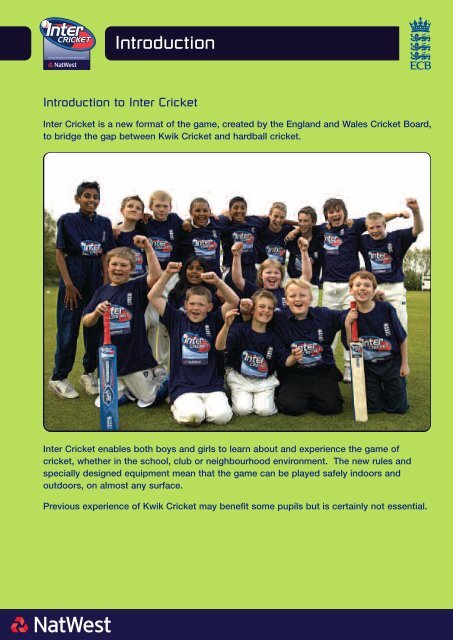
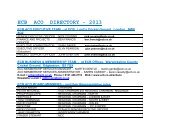
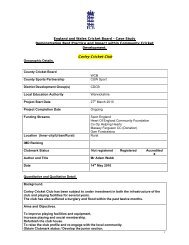
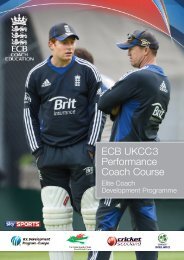

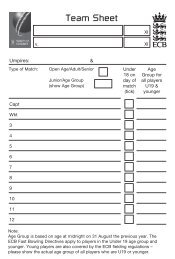
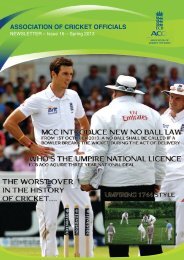
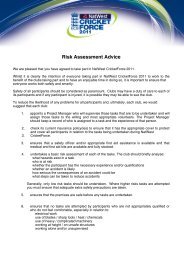
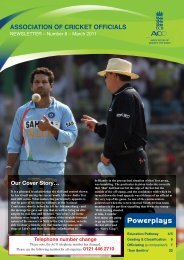


![Indoor Sports Halls with Cricket Provision [TS3] - Ecb - England and ...](https://img.yumpu.com/49070696/1/190x135/indoor-sports-halls-with-cricket-provision-ts3-ecb-england-and-.jpg?quality=85)



